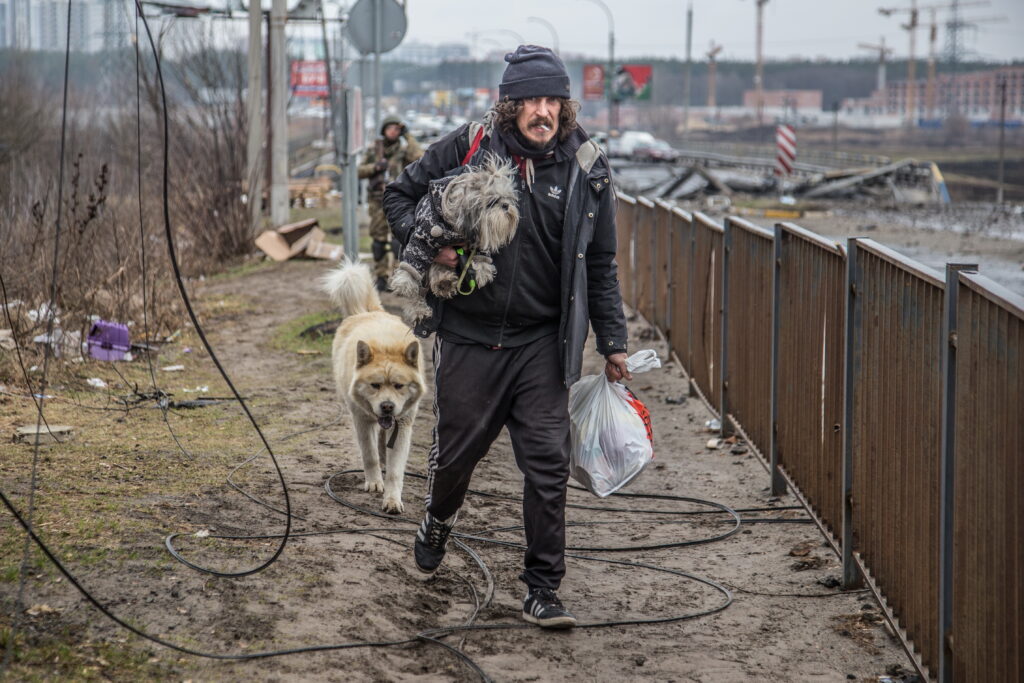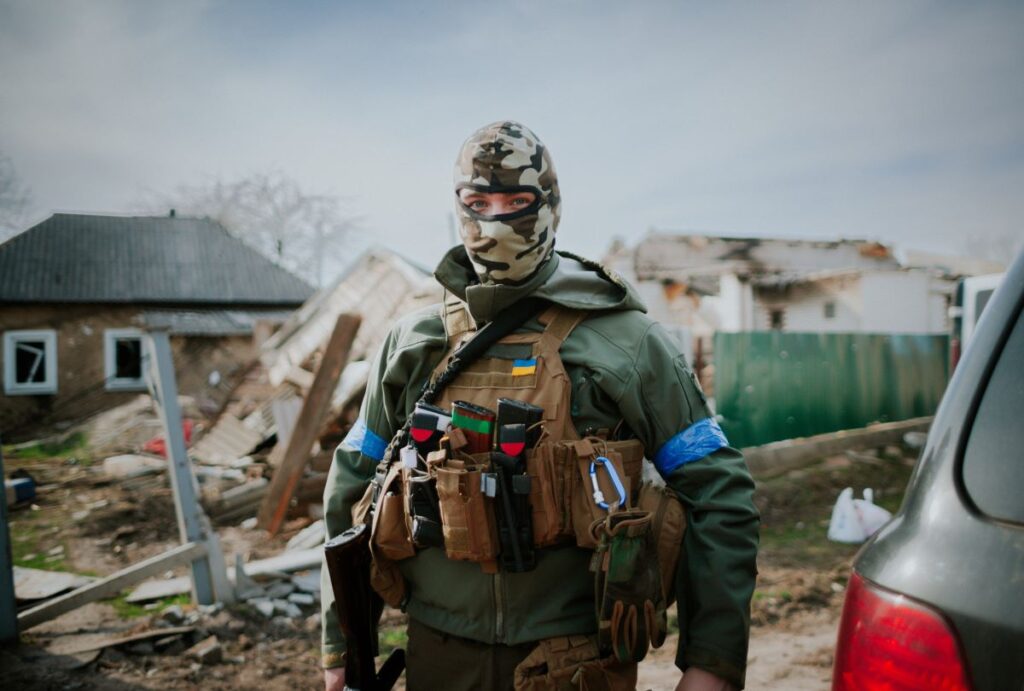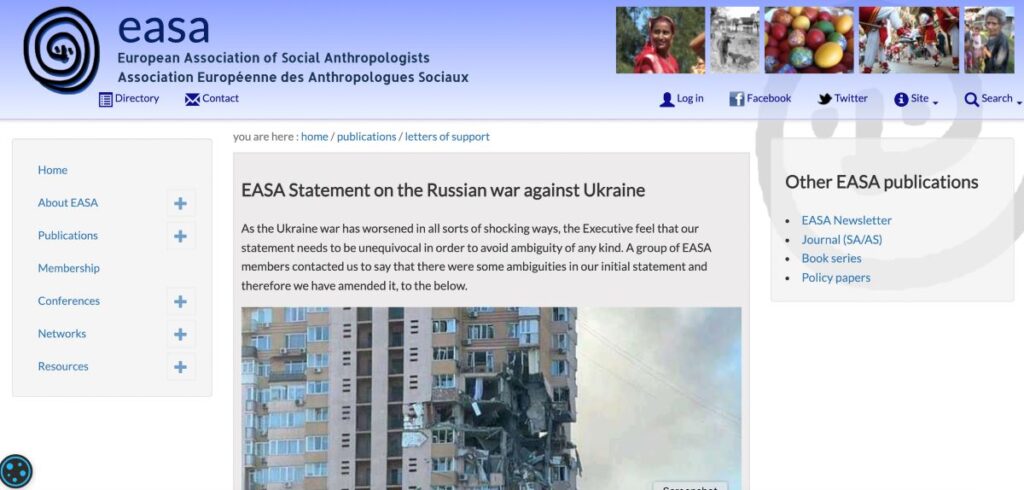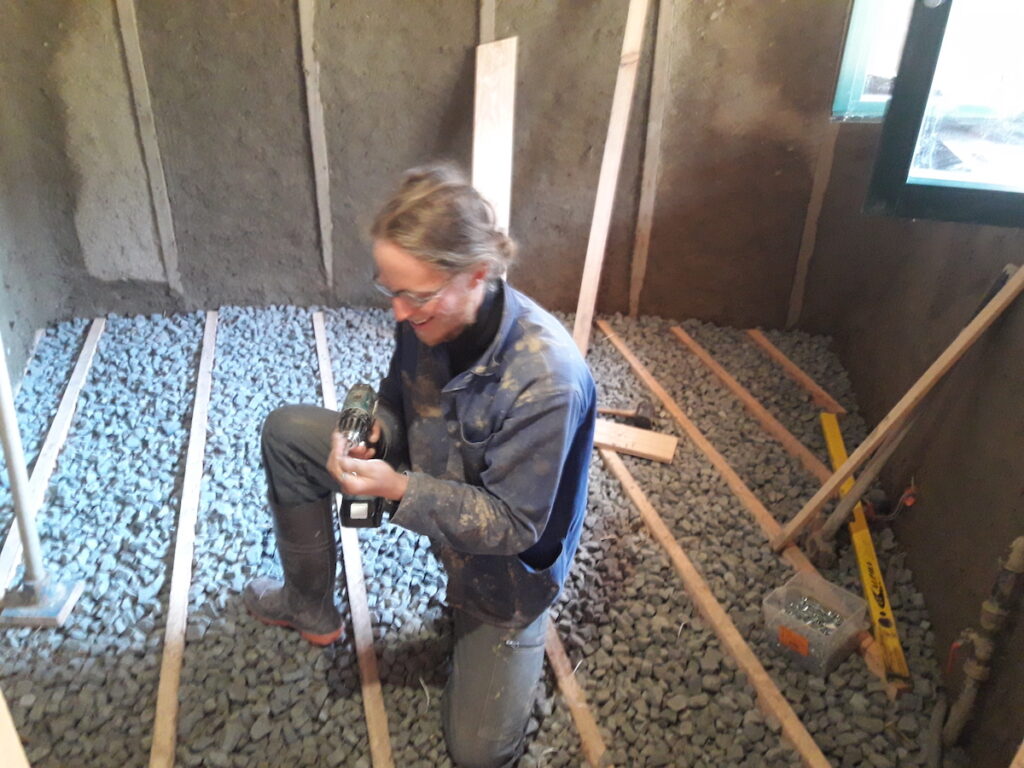The debate around the Russian invasion of Ukraine, including the previous contributions in FocaalBlog, has shifted from the ‘either NATO or Russia’ dichotomy to a more nuanced exchange along the lines of ‘it is NATO, but…’ versus ‘it is Russia, but…’. In a welcome development, discussants started following Tony Wood’s (2022) advice to ‘ascribe weights’ to the factors leading to Russia’s invasion. It is also the intention of this text. However, rather than doing so quantitatively, and ascribing ‘weights’ to each individual actor, I aim, like Don Kalb (2022), at presenting a relational narrative.
Beside my interrupted fieldwork in Ukraine (2021), this contribution to the war debate is based on my fieldwork in Belarus (2015-2017) and my conclusions on how Lukashenka’s ‘Caesarist regime’ mutated when faced with popular and geopolitical challenges to its ‘passive-revolutionary strategy’ (Artiukh 2020, 2021), to use Gramsci’s vocabulary. Drawing on my insights from Ukraine and Belarus, I sketch the political logic of Russia’s aggressive territorial expansion against the backdrop of US hegemonic decline. I claim that this expansion, driven by the logic of legitimism whereby Russia offers its prospective clients a new anti-revolutionary ‘Holy Alliance,’ as Tsarist Russia did in the 19th century, and engenders a system of ‘anti-Maidan’ regimes that share important cultural and political commonalities.
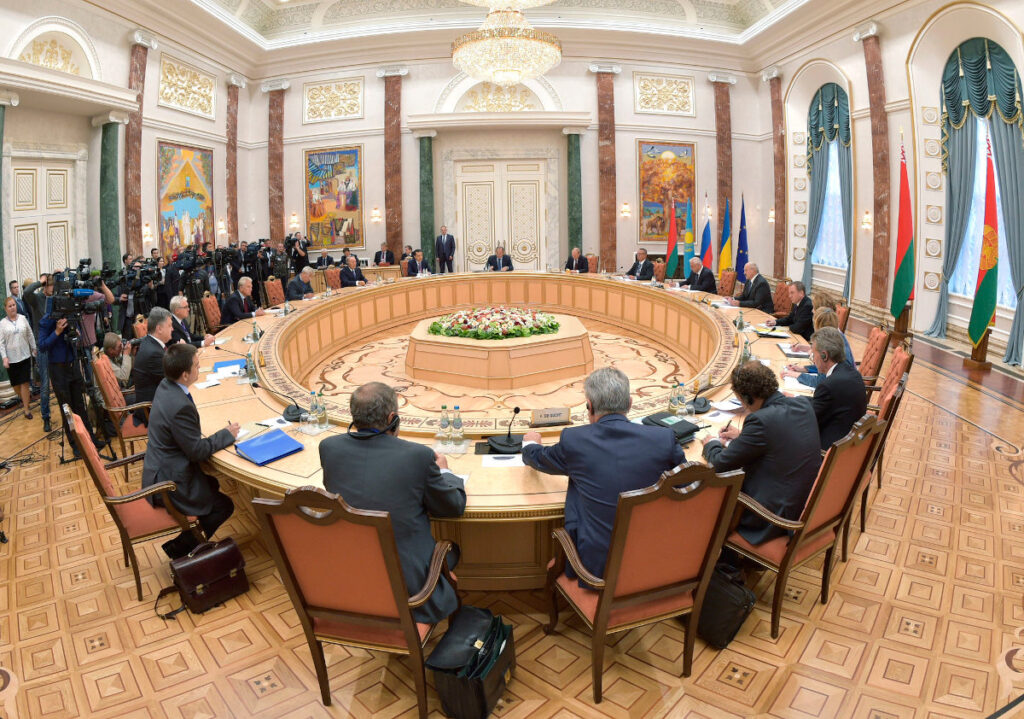
This political logic, clearly formulated in Putin’s 2015 UN speech follows a shift in Russian imperialist strategy. According to the political economist Ilya Matveev (2021), Russian imperialism transitioned from the economic logic to the territorial logic around the year 2014, when the Russian state resigned from the strategy of expanding private businesses to Ukraine and other post-Soviet republics and started waging political control over these territories even at the expense of the interests of private capital. The most salient example of this new strategy was the annexation of Crimea and the support for the pro-Russian rebels in Donbass. However, the strategy seems to be broader and includes the reactivation of other ‘frozen conflicts’ (Georgia 2008, possibly Moldova), involvement in domestic conflicts (Ukraine 2014, Belarus 2020, Kazakhstan 2022), and provision of military services (Syria and several African countries).
The central tenet of this legitimist territorial strategy was the conservation of neopatrimonial regimes threatened by popular discontent. The Donbass break-away statelets were the first in a series of regimes that started appearing in the post-Soviet space since 2014 in reaction to the real or perceived threat of popular protests. I call such forms of governance ‘anti-Maidan’ regimes in reference to their first legitimizing narrative of resisting Ukraine’s Maidan protests. What unites them is the fact that they are reactions to populist uprisings, foster the demobilization rather than mobilization of their populations, and rely on police and military coercion rather than hegemonic projects. As elites in need joined this Holy Alliance, their regimes transformed accordingly: these include Assad’s Syria, Lukashenka’s Belarus, most recently Kazakhstan, and the newly occupied regions of Ukraine. Bringing this logic back home, Russia’s own regime has undergone a transformation into an authoritarian police state with post-fascist tendencies.
This project should be traced back to the continued organic crisis that burst to the surface in 2008 and made the situation on the eve of the 2013 Maidan uprising possible. The Ukrainian Maidan protests were one of the localized ‘worldwide mobilizations’ (Kalb & Mollona, 2018) against neoliberalized neopatrimonial regimes under the strain of the crisis, best epitomized by the Arab Spring. Formed around the territorialized condensation of political passions, such uprisings were rooted in something akin to Sorel’s political myth that was able to create a cleavage between ‘us and them’ but unable to produce lasting change because of the lack of organizational frameworks and leadership. Therefore, it was the more radical violent groups that took advantage of such movements, the contemporary condottiere that, nevertheless, were not able to embody the collective will (Gopal, 2020).
These post-developmental neopatrimonial regimes were in different stages of decline and stood in different relations with their neighbours. Thus, the Tunisian and Belarusian regimes, being able to rely on their patrons and having stronger states, were able to incorporate the uprisings in their continuing passive revolutionary strategies. Others suffered from the intervention of their neighbours, as it happened in Bahrain, Yemen, and Ukraine. Still others plunged into a prolonged civil war, such as Libya or Syria, and became a battleground of competing US, Turkish, and Russian imperialisms.
Contrary to wide-spread preconception, the US demonstrated a failure of its hegemony when faced with these situations. Here I use hegemony in a Gramscian-Arrighian sense, as a set of institutions and ideologies buttressed by the potentiality of the use of credible force that can overcome crises and align the interest of core and peripheral elites. Whereas the US central bank managed to relatively successfully mitigate the crisis of 2008 in Europe, it failed to establish order in its periphery (Tooze, 2019). Similarly, the US military operations brought unintended consequences. Once this hegemonic hole opened and the US showed its weakness, a ‘shitshow’ emerged, in Obama’s words, as the contenders immediately sprang to action offering their help to restore order.
One hegemonic contender was Russia, one of the neopatrimonial regimes whose decline was only beginning to show itself. The first signs of this decline appeared in the urban middle class protests of 2011-2013 and were quickly suppressed. Since domination in international relations, according to Gramsci, is an extension of the modes of domination of the ruling class, Russia’s system of neopatrimonial international dependencies was also slipping away. Thus, Russia came up with a doctrine of the support of ‘legitimate regimes’ against the hybrid war waged by the west (Göransson, 2021). As an alternative of the faltering US hegemony based on the ‘promotion of democracy’ including the support of popular uprisings, Russia came up with an offer of a Holy Alliance for the 21st century. In Gramscian terms, this was an offer of the preservation of the historical bloc that is based on Ceasarist domination rather than hegemony. Thus, as opposed to the faltering US hegemony, Russia offered an international system of domination without hegemony. Such an offer would solve two tasks: bolster the rule of the Russian domestic regime and ensure the stability of the regimes of the states that join the Holy Alliance.
This is how one can read the post-Maidan developments. The fall of Yanukovych signalled the fragility of the neopatrimonial regimes and thereby threatened Russia as the provider of security guarantees after Yanukovych accepted such offer in late 2013. The weak political-mythical quality of the Maidan uprising ended in the ‘us and them’ cleavage, thus alienating a considerable part of Ukraine’s population (Zhuravlev & Ishchenko, 2020). Expectedly, it followed by the stage of far right condottierism that further widened the cleavage. Europe was disoriented and the US was cautious to get involved in yet another ‘shitshow.’ The annexation of Crimea and the fuelling of the civil war in Ukraine was the logical application of the legitimism doctrine. This first move was a typically Ceasarist one, a special operation of Putin’s ‘praetorian guard’. The goal of bolstering domestic legitimacy was attained by the so-called Crimea effect, while the goal of establishing the legitimate order in Ukraine was in process.
Russian analysts expected that the post-Maidan government would not differ much from the previous one and thus would need a donor of security against the separatist threat that Russia itself fuelled. Russian leadership also knew that neither the EU nor the US would be willing to become such donors to the full extent required. Thus, they offered the package of the so-called Minsk agreements which was a military-diplomatic consecration of Russia’s military victory over the weak post-Maidan regime. The Minsk agreements envisaged the presence of the de facto Russian political and military forces within a federal Ukrainian state that would potentially win the ensuing civil war (Koshiw, 2022). The EU had no other choice than trying to freeze the ‘no war no peace’ situation hoping that it would solve itself in the future. The US largely kept at a distance during the Trump interregnum.
However, the Kyiv authorities and the heirs of the Maidan condottiere fought to avoid this situation tooth and nail. They imposed the post-Maidan consensus, profiting from the cleavage opened by the Maidan political passions and supported by the condottiere. With some limited help from the EU and the US, the Kyiv authorities managed to re-establish state institutions and rebuild the army. The West had no choice but to accept the new Kyiv Caesarism. This time Russia decided to wait while developing the separatist republics in Donbass as the outpost for the coming battle.
By that time, the LNR/DNR, kept together by the perpetual state of emergency and harsh repressions against dissident political, cultural and labour activists, became a grey zone controlled by the Russian public and private agencies (Savelyeva, 2022). Having consolidated its sovereignty over the anti-Maidan outpost in Donbass, Russia claimed an undisputed success in Syria by reviving Assad’s rule over most of the country and burying the remnants of the 2011 uprising. Finally, the post-2020 Belarus, which switched from authoritarian populism to an outright dictatorial police state (Artiukh, forthcoming), was undoubtedly the most successful case of Russia’s international assistance within the Holy Alliance. Similarly to the leadership of LNR/DNR, Lukashenka constructed his post-protest legitimacy as a machine-gun brandishing saviour of the country from a west-inspired coup attempt, which explicitly compared to Ukraine’s Maidan. Not only did Russia’s political, media and economic support succeed in stabilizing Lukashenka’s regime but also managed to tie it to Russia, thus securing a military lodgement.
This series of successes against the background of the American and European failures emboldened the Russian elites. While Russia reinstated the power of Assad in Syria, exported its services to African countries, and crashed protests at home, the US was mired in the Trump ‘shitshow’ internally, nearly losing NATO allies, announcing a pivot to Asia, and losing miserably at the withdrawal from Afghanistan. The only unfinished business for the Holy Alliance was Ukraine. Since the beginning of 2020, Russia started integrating the separatist statelets in Donbass into the Russian ideological, economic, and political sphere while simultaneously pressing the Ukrainian authorities to hastily implement the political part of the Minsk agreements.
After a brief flirtation with Putin, Zelensky’s government realized it could not reinstate sovereignty over the separatist regions if the Minsk process was supervised by Russia and domestic politics was contested by nationalists. Russia’s actions hinted at the possibility of either fully integrating these statelets into Russia following the Crimea example or using them as the outpost of the ‘Russian world,’ as proclaimed in the ideological doctrine of LNR/DNR in early 2021. According to some analysts, that’s the time when the Russian authorities started preparing for the eventuality of a full-fledged military operation against Ukraine. Next steps were only a question of time and opportunity.
This opportunity came in late 2021 or early 2022. Many factors converged that would weaken the West and embolden Russia, and Russian elites understood this. Not only were the US and Europe hit by the pandemic, but they also faced political transitions: the new and weak president in the US who continued the pivot to Asia, the new chancellor in Germany and the coming elections in France. Things were going much better for Russia: Belarus was securely under Russia’s control as a poster child of the Holy Alliance, Russia’s economy stabilized and accumulated all-time high resources, the lighting fast special operation in Kazakhstan would prove Russia as a reliable donor of security. Thus, Russia announced its assault with the first war scare of the April 2021 that seemingly opened a dialogue on the matters of strategic security between the US and Russia. After that Putin and Medvedev wrote their texts about Ukraine and Zelensky, essentially offering an ultimatum: either Ukraine would be destroyed as a state, or it would be refashioned according to the Russian will.
Zelensky was probably aware of the coming danger, therefore he stepped up the cleansing of the domestic political domain and tried to improve the army as much as possible while still clinging to the ceasefire in the Donbass. He hoped to balance his way out of the narrow road ahead of him. Russia meanwhile rolled out another ultimatum in December 2022 that already asked for the withdrawal of the NATO infrastructure from the former Warsaw Pact countries in addition to a ban on accepting new NATO members. Much like Austria’s ultimatum against Serbia in 1914, Putin’s was also not meant to be met. After some initial setbacks, the Russian army has continued to occupy Ukraine’s territory beyond LNR/DNR, keeping the political goals of the war deliberately vague.
Three months into the war, the newly occupied territories in the south of Ukraine are controlled by the methods developed by other anti-Maidan regimes, primarily Belarus and LNR/DNR. The tremendous success of Lukashenka’s crackdown against those who protested the results of the unfair elections in 2020 relied on unprecedented police brutality, long-term jail sentences, and the demoralization of dissenters. Having abandoned his trademark populism, Lukashenka proved that brute force alone might work if people are sufficiently atomized in cities and on the shopfloor. Initial mass demonstrations against the Russian occupation have been dispersed as Russia strengthened its policing capacity in the rear of the invading army. There are reports of political activists being kidnapped and tortured, repeating the Donbass experience. One of the methods used in Belarus, the systematic video-taping of forced self-denunciations, was recently repeated in Kherson oblast, where people unhappy with the occupation were forced to apologize on camera and say that they have ‘completed a denazification course.’ This is not accompanied by any coherent ideological narrative; instead, Russian media project a wild mix of Soviet, Tsarist, and vaguely fascist symbols whose sole purpose is to intimidate and show that the resistance is futile (Artiukh, 2022).
While constructing the system of anti-Maidan regimes, Russia has also transformed itself from a ‘managed democracy’ into a police state with post-fascist tendencies and imposing a postmodern mix of ideologies that are not meant to truly persuade the masses (Budraitskis, 2022). If the US presided over the emergence of post-Soviet world by promoting neoliberal textbooks and failing to create a hegemonic security paradigm, Russia’s anti-Maidan strategy accomplished the end of post-Sovietness by destroying all remnants of the Soviet civilization that the successor states fed on. On the one hand, this is symbolic decommunization – from the literal destruction of monuments in Ukraine to the zombification of Soviet symbols which are being turned into symbols of the colonial conquests of the Russian Federation; on the other hand, it is political and economic “decommunization” – the delegitimization of the borders of the former republics and the destruction of the centers of Soviet industrialization in the Donbass, Mariupol, or Kharkov. The long decline of pax postsovietica is almost over.
Volodymyr Artiukh is a Postdoctoral Researcher at COMPAS with the ERC-funded project EMPTINESS: Living Capitalism and Democracy after (Post)Socialism. He completed his PhD in Sociology and Social Anthropology at the Central European University in 2020 with a dissertation about labour and bureaucratic control in Belarus. His research interests include the anthropology of labour and migration in post-Soviet countries, the anthropology of populism, and the study of hegemony in Eastern Europe.
This text was presented at the conference ‘New Times? Confronting the Escalating Crises of Capitalism’ in Budapest 26-27 May, organized by the Karl Polanyi Research Center for Global Social Studies and the Commission of Global Transformations and Marxian Anthropology-IUAES in cooperation with the Working Group for Public Sociology ‘Helyzet’, ‘Capitalism Nature Socialism’, ‘Focaal – Journal of Global and Historical Anthropology’, and ‘FocaalBlog’.
References
Artiukh, V. (2020). The People against State Populism. Belarusian protests against the “Social parasite law.” Schweizerisches Archiv Fur Volkskunde, 116(1), 101–116.
Artiukh, V. (2021). The anatomy of impatience: Exploring factors behind 2020 labor unrest in Belarus. Slavic Review, 80(1), 52–60.
Artiukh, V. (2022). Destruction of signs, signs of destruction. Emptiness, May 9. https://emptiness.eu/field-reports/destruction-of-signs-signs-of-destruction/.
Artiukh, V. (Forthcoming). Dramaturgy of Populism: Post-electoral protest ideologies in Belarus. New Europe College Yearbook. Pontica Magna Program.
Budraitskis, I. (2022). From Managed Democracy to Fascism. Tempest, April 23. https://www.tempestmag.org/2022/04/from-managed-democracy-to-fascism/
Gopal, A. (2020). The Arab Thermidor. Catalyst, 4(2).
Göransson, M. (2021). Understanding Russian thinking on gibridnaya voyna. In M. Weissmann, N. Nilsson, B. Palmertz & P. Thunholm (Eds.), Hybrid Warfare: Security and Asymmetric Conflict in International Relations (pp. 83–94). London: I.B. Tauris.
Kalb, D. (2022). War: New Times. FocaalBlog, 21 April. https://www.focaalblog.com/2022/04/21/don-kalb-war-new-times/
Kalb, D. & Mollona, M. (2018). Introductory Thoughts on Anthropology and Urban Insurrection. In D. Kalb & M. Mollona (Eds.), Worldwide Mobilizations: Class Struggles and Urban Commoning. New York and Oxford: Berghahn Books.
Koshiw, I. (2022). Everyone is talking about Minsk but what does it mean for Ukraine? Open Democracy, 4 February. https://www.opendemocracy.net/en/odr/russia-ukraine-what-are-the-minsk-agreements/
Matveev, I. (2021). Between Political and Economic Imperialism: Russia’s Shifting Global Strategy. Journal of Labor and Society, 25(2), 198–219.
Savelyeva, N. (2022). Eight Years of War before the War. Rosa Luxemburg Stiftung, March 25. https://www.rosalux.de/en/news/id/46205.
Tooze, J. A. (2019). Crashed: How a decade of financial crises changed the world. Penguin Publishing Group.
Wood, T. (2022). Matrix of War. New Left Review, 133/134.
Zhuravlev, O., & Ishchenko, V. (2020). Exclusiveness of civic nationalism: Euromaidan eventful nationalism in Ukraine. Post-Soviet Affairs 36(3), 226-245.
Cite as: Artiukh, Volodymyr. 2022. “The political logic of Russia’s imperialism.” Focaalblog, 9 June.
https://www.focaalblog.com/2022/06/09/volodymyr-artiukh-the-political-logic-of-russias-imperialism/



